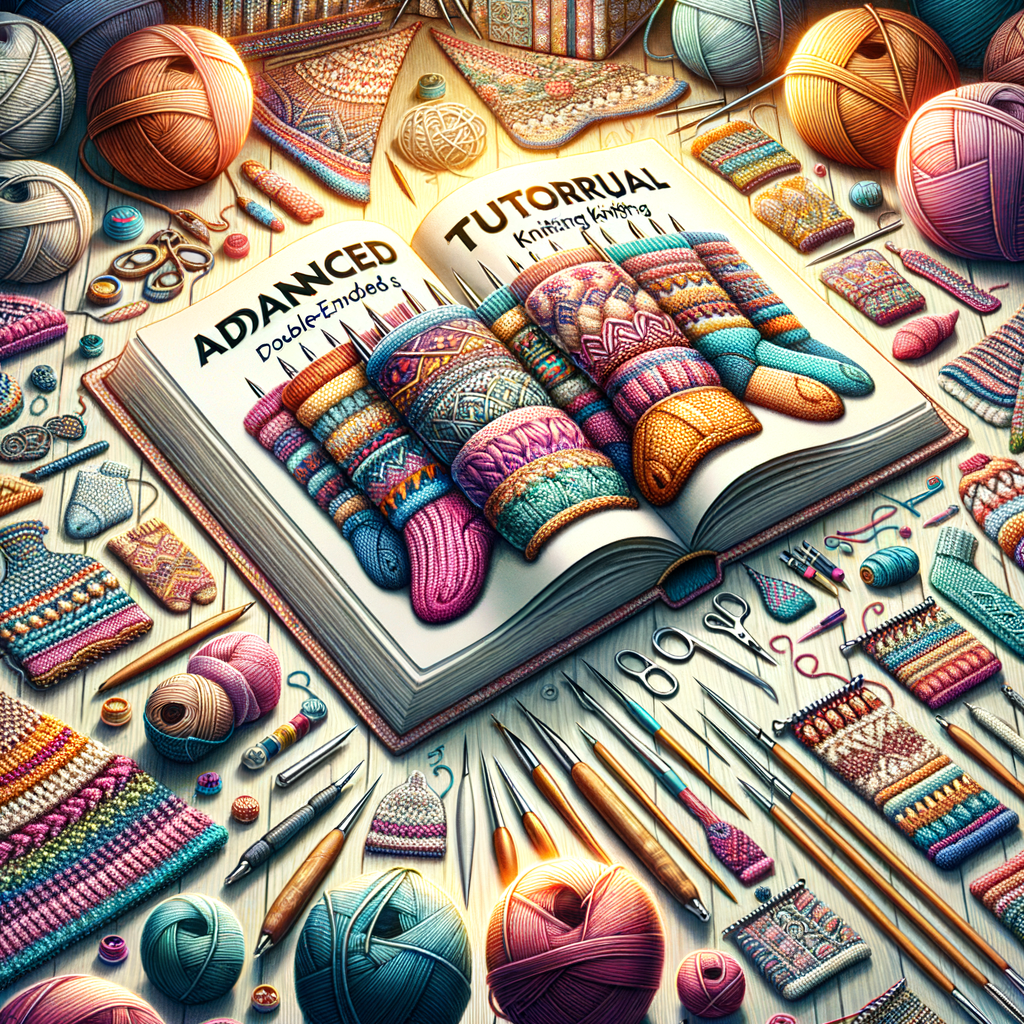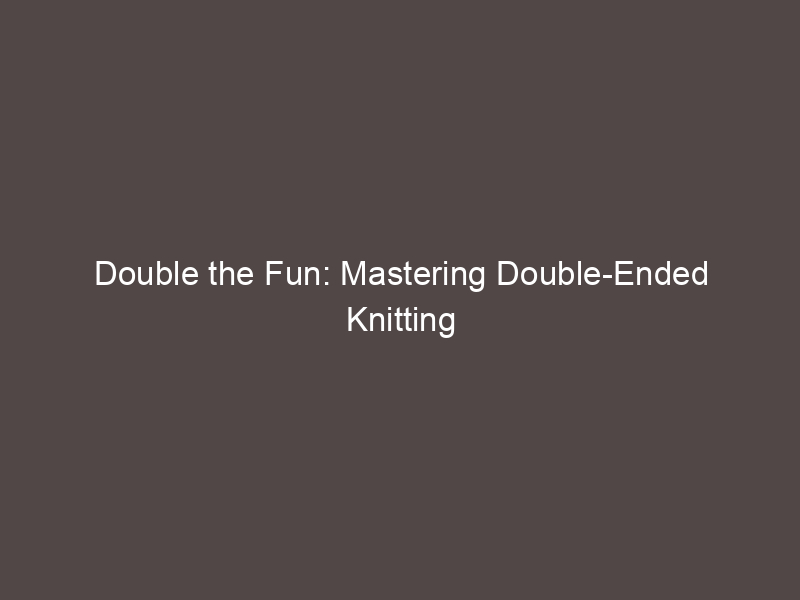
Introduction to Double-Ended Knitting
Double-ended knitting, also known as double-knitting, is a fascinating and versatile knitting technique that’s been around for centuries. In this article, we will explore the definition of double-ended knitting, its history and origin, and the benefits it offers to knitting enthusiasts.
- Definition of Double-Ended Knitting
- History and Origin of Double-Ended Knitting
- Benefits of Double-Ended Knitting
Double-ended knitting is a unique knitting technique that involves using two working ends of yarn, often from two separate balls, to create a two-layered, reversible fabric. This technique is achieved by alternating between the two yarns, knitting with one and purling with the other, resulting in a fabric that is twice as thick and warm as regular knitting.
Double-ended knitting has a rich history that dates back to the 16th century. It is believed to have originated in Spain before spreading to other parts of Europe, including Scandinavia and the British Isles. The technique was used to create warm, durable clothing items such as socks and mittens, which were essential in colder climates. Over the years, double-ended knitting has evolved and is now used to create a wide range of items, from hats and scarves to blankets and sweaters.
Double-ended knitting offers numerous benefits. Firstly, it allows for the creation of a two-sided, reversible fabric, which is perfect for items like scarves and blankets. Secondly, the resulting fabric is thicker and warmer, making it ideal for winter wear. Additionally, double-ended knitting opens up a world of design possibilities, as different colors and patterns can be used on each side of the fabric. Lastly, it’s a great technique for improving your knitting skills and challenging yourself with a new and exciting project.
In the following sections, we will delve deeper into the world of double-ended knitting, providing a guide on how to get started, showcasing some inspiring double-ended knitting projects, and sharing resources and tutorials to help you master this technique. So, whether you’re a seasoned knitter looking for a new challenge or a beginner eager to learn, stay tuned for an exciting journey into the world of double-ended knitting.
Double-Ended Knitting Guide
Double-ended knitting is a versatile and rewarding skill. This guide will help beginners understand the basics and start their first project.
Double-Ended Knitting for Beginners
Starting a new craft can be daunting, but with the right tools, a little understanding, and some simple project ideas, you’ll be on your way to becoming a double-ended knitting pro.
- Basic Tools and Materials
- Understanding Double-Ended Knitting Patterns
- First Double-Ended Knitting Project Ideas
For double-ended knitting, you’ll need two double-pointed knitting needles and yarn. Choose a medium-weight yarn for your first project as it’s easier to handle. You’ll also need a pair of scissors and a yarn needle for finishing your project.
Double-ended knitting patterns might seem complex at first, but they’re just a series of instructions. Each row of the pattern represents one row of stitches on your needles. The most common stitches are ‘knit’ and ‘purl’, represented by ‘K’ and ‘P’ in the pattern. Practice these stitches until you feel comfortable with them.
Start with a simple project like a scarf or a dishcloth. These projects only require you to knit back and forth, making them perfect for beginners. Once you’ve mastered these, you can move on to more complex projects like hats or socks.
Remember, the key to mastering double-ended knitting is practice. Don’t be discouraged if your first few attempts don’t turn out perfectly. Keep trying, and soon you’ll be creating beautiful double-ended knitted items.
Advanced Double-Ended Knitting Techniques
As you continue to grow your double-ended knitting skills, there are a few advanced techniques that can help you create more complex and intricate designs. Let’s explore these techniques in detail.
- Mastering the Double-Ended Knitting Stitch
- Creating Intricate Double-Ended Knitting Patterns
- Double-Ended Knitting Tips for Advanced Knitters
- Practice Regularly: The more you practice, the better you’ll get. Try to knit a little bit every day.
- Experiment with Different Yarns: Different yarns can create different effects. Don’t be afraid to try something new.
- Take Breaks: Knitting can be strenuous on your hands and eyes. Make sure to take regular breaks to prevent strain.
Mastering the double-ended knitting stitch is a crucial step in advancing your knitting skills. This stitch is unique because it involves using both ends of the knitting needle, which allows you to create two layers of fabric at the same time. To master this stitch, practice consistently and focus on maintaining even tension throughout your work. Remember, practice makes perfect!
Once you’ve mastered the double-ended stitch, you can start creating intricate patterns. These patterns can range from simple geometric designs to complex images. Start by sketching your design on graph paper, then translate it into a knitting pattern. Don’t be afraid to experiment and try new things. The more you practice, the more intricate your designs will become.
Even for advanced knitters, there’s always something new to learn. Here are a few tips to help you improve your double-ended knitting skills:
With these advanced techniques and tips, you’ll be well on your way to becoming a master of double-ended knitting. Remember, the key to mastering any skill is patience and practice. Happy knitting!
Double-Ended Knitting Projects
Double-ended knitting is a versatile technique that allows you to create beautiful, two-sided fabrics. If you’re looking for project ideas to put your double-ended knitting skills to use, we’ve got you covered. Here are three project ideas that are not only fun to make but also practical and stylish.
Project Ideas for Double-Ended Knitting
-
Double-Ended Knitted Scarf
A double-ended knitted scarf is a wonderful project to start with. This project allows you to experiment with different colors and patterns. The end result is a warm, cozy scarf that’s perfect for cold weather. Plus, with the double-ended knitting technique, your scarf will look great from both sides!
-
Double-Ended Knitted Hat
Next on our list is a double-ended knitted hat. This project is a bit more challenging than the scarf, but it’s definitely worth the effort. A double-ended knitted hat is not only warm and comfortable, but it also adds a unique touch to your winter wardrobe. And just like the scarf, it looks fantastic from all angles.
-
Double-Ended Knitted Sweater
If you’re up for a bigger challenge, why not try a double-ended knitted sweater? This project requires more time and patience, but the result is a beautiful, one-of-a-kind sweater that’s sure to turn heads. The double-ended knitting technique gives the sweater a unique, two-sided design that’s both stylish and cozy.
These are just a few examples of what you can create with double-ended knitting. The possibilities are endless, so don’t be afraid to get creative and try your own project ideas. Happy knitting!
Case Studies: Successful Double-Ended Knitting Projects
- Case Study 1: The Double-Ended Knitted Blanket
Our first case study focuses on a beautiful double-ended knitted blanket. This project was completed by a beginner knitter who had just learned the double-ended knitting technique. Despite her limited experience, she was able to create a warm, cozy blanket with a unique, intricate design.
The knitter used two different colors of yarn, which added depth and contrast to the blanket. She followed a simple pattern, alternating between the two yarns every few rows. The result was a stunning blanket that showcased the versatility of double-ended knitting.
Project Details Time to Complete: 2 weeks Yarn Used: Acrylic, medium weight Pattern: Alternating color rows - Case Study 2: The Double-Ended Knitted Shawl
Our second case study is a double-ended knitted shawl, created by an intermediate knitter. This project showcased the potential of double-ended knitting to create intricate, detailed patterns.
The knitter used a lace pattern, which required careful attention to detail and precision. Despite the complexity of the pattern, the double-ended knitting technique made it easier to manage. The finished shawl was lightweight, yet warm, and featured a beautiful, intricate design.
Project Details Time to Complete: 1 month Yarn Used: Wool, light weight Pattern: Lace pattern - Key Takeaways from Successful Double-Ended Knitting Projects
These case studies highlight the versatility and potential of double-ended knitting. Whether you’re a beginner or an experienced knitter, this technique can help you create beautiful, unique projects.
Key takeaways include the importance of choosing the right yarn and pattern for your project, the value of patience and precision, and the potential for creativity and individuality in double-ended knitting. With practice, you too can create stunning double-ended knitted projects!
Learn Double-Ended Knitting: Resources and Tutorials
Learning double-ended knitting can be a fun and rewarding experience. There are many resources available to help you master this skill. Here are some of the best resources and tutorials to get you started.
- Best Books for Learning Double-Ended Knitting
- “Double-Ended Knitting Made Easy” – This book breaks down the process of double-ended knitting into simple, easy-to-understand steps.
- “Mastering Double-Ended Knitting” – This book provides more advanced techniques for those who have mastered the basics.
- “Double-Ended Knitting Projects” – This book is filled with fun and creative projects to help you practice your double-ended knitting skills.
- Online Double-Ended Knitting Tutorials
- “Double-Ended Knitting for Beginners” – This tutorial covers the basics of double-ended knitting and is perfect for beginners.
- “Advanced Double-Ended Knitting Techniques” – This tutorial covers more advanced techniques for those who have mastered the basics.
- Double-Ended Knitting Workshops and Classes
- “Double-Ended Knitting Workshop” – This workshop covers the basics of double-ended knitting and provides hands-on practice.
- “Advanced Double-Ended Knitting Class” – This class covers more advanced techniques for those who have mastered the basics.
Books are a great resource for learning double-ended knitting at your own pace. Here are some of the best books on the subject:
Online tutorials are a convenient way to learn double-ended knitting. They allow you to learn at your own pace and you can pause and replay the tutorials as needed. Here are some recommended online tutorials:
Workshops and classes provide hands-on learning experiences. They also give you the opportunity to ask questions and get immediate feedback. Here are some recommended workshops and classes:
With these resources and tutorials, you’ll be well on your way to mastering double-ended knitting. Remember, practice makes perfect. Happy knitting!
Conclusion: The Joy of Double-Ended Knitting
As we wrap up our exploration of double-ended knitting, let’s take a moment to reflect on the journey we’ve taken together. We’ve learned new techniques, discovered exciting projects, and even found a new way to relax and unwind. Let’s delve into the highlights of our journey.
- Recap of Double-Ended Knitting Techniques and Projects
- The Therapeutic Benefits of Double-Ended Knitting
- Encouragement to Continue Exploring Double-Ended Knitting
We started with the basics, learning the unique techniques that make double-ended knitting possible. From the simple knit and purl stitches to more complex patterns, we’ve seen how this method can create beautiful, reversible fabric. We’ve also explored a variety of projects, from scarves and hats to blankets and bags, proving that double-ended knitting is as versatile as it is fun.
Double-ended knitting isn’t just a hobby, it’s a form of therapy. The rhythmic, repetitive motion of the needles can help reduce stress and anxiety, while the sense of accomplishment from completing a project can boost self-esteem. Plus, the act of creating something beautiful and useful can provide a sense of purpose and satisfaction.
Our journey doesn’t have to end here. There are still so many techniques to learn, patterns to try, and projects to create. So, keep your needles ready and your yarn stash stocked. Continue to explore the world of double-ended knitting, and let the joy of this craft be a constant companion on your creative journey.
Remember, the beauty of double-ended knitting lies not just in the finished product, but in the process itself. So, take your time, enjoy each stitch, and let your creativity flow. Happy knitting!






